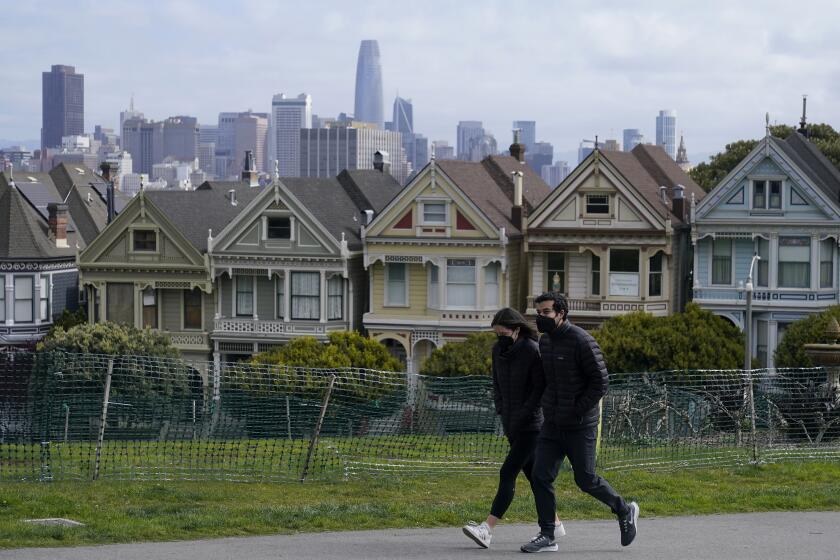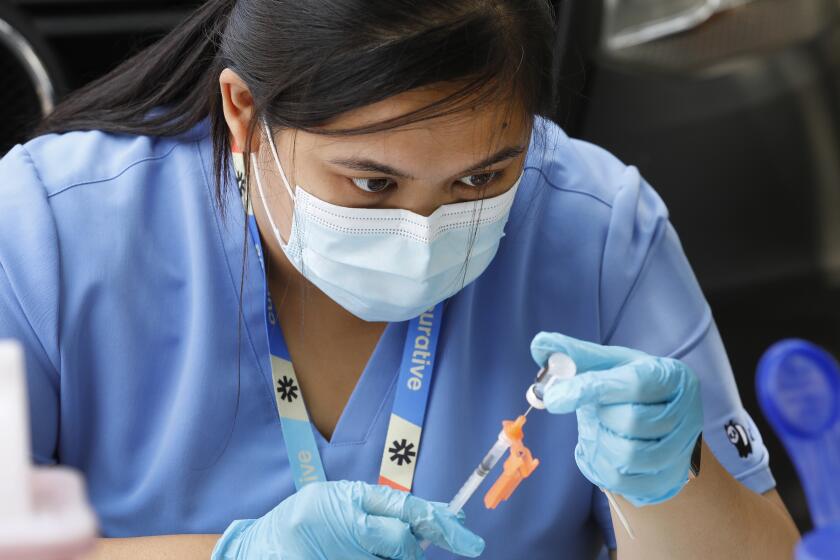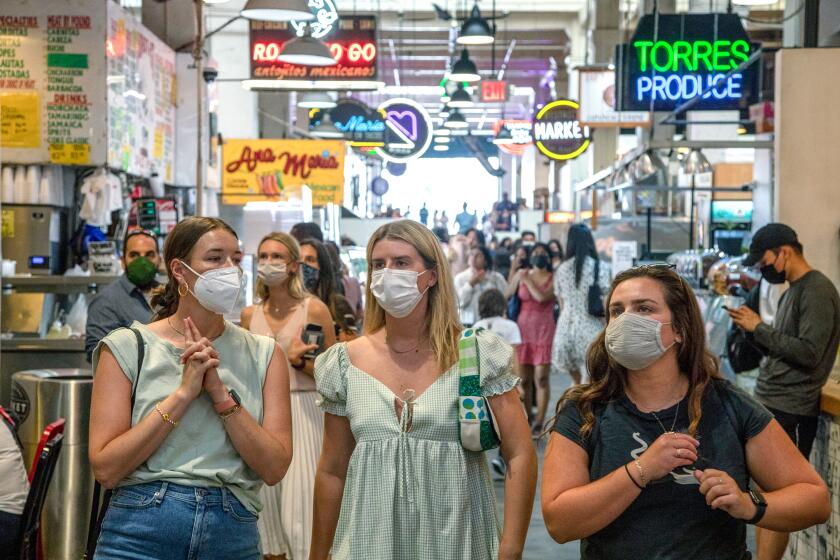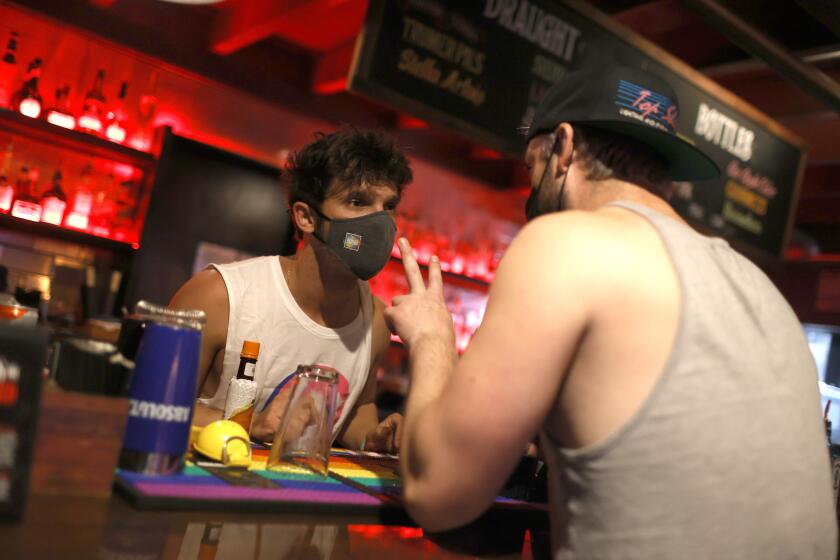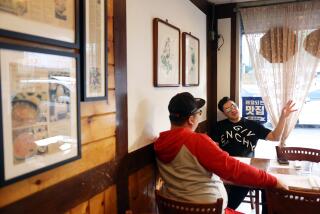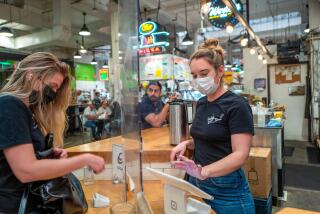California sees significant rise in vaccinations as employers issue mandates
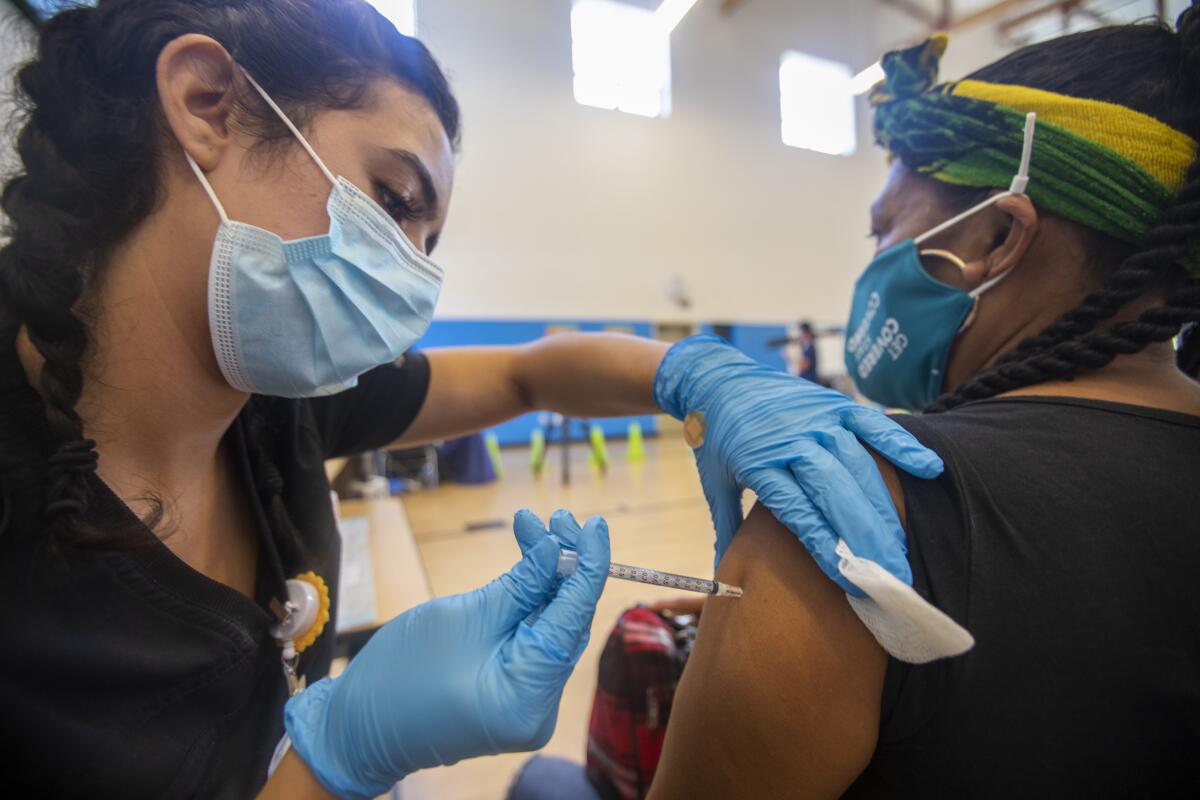
- Share via
California has seen a substantial increase in the number of people getting vaccinated against COVID-19 over the last two weeks, a turnabout that comes as a growing list of municipalities, businesses and venues are moving to require the shots for employees and, in some cases, even customers in hopes of slowing the latest surge.
The recent boost is a promising development after weeks of rising coronavirus cases and hospitalizations fueled by the highly infectious Delta variant of the virus — a tide officials say can eventually be turned if significant numbers of unvaccinated people roll up their sleeves.
Amid this new surge in infections and illness, a growing number of both public and private sector employers are moving toward mandating their workers be vaccinated.
Two Los Angeles County supervisors on Tuesday proposed a vaccine verification requirement for more than 100,000 government workers, a day after health giant Kaiser Permanente announced it was making vaccines mandatory for all employees and physicians, as nearly a quarter of its 240,000 employees remain uninoculated.
More retailers and restaurants are also beginning to require customers to provide proof of their inoculation status.
Whether because of a forthcoming mandate, fears over the Delta variant or other reasons, California’s vaccination pace has increased of late after months of decline.
From July 25 to 31, providers throughout California administered an average of nearly 44,000 first vaccine doses per day, according to data compiled by The Times.
That’s up notably from the previous week, when an average of about 37,300 first doses were doled out daily; and a 41% increase from two weeks ago, when the average was just under 31,100.
These figures cover both those who received their initial dose of the Pfizer-BioNTech or Moderna vaccine or the single-shot Johnson & Johnson vaccine.
California’s vaccination pace still lags far behind its springtime peak, however. Over the week of April 4 to 10, for example, providers were administering roughly 251,000 first doses per day, on average.
Residents in a large swath of the Bay Area will again need to wear masks indoors, regardless of vaccination status, officials announced Monday.
Even with the recent uptick, it will probably take months before enough Californians are inoculated to reach herd immunity: the level at which sustained transmission of the virus is interrupted.
Estimates of that threshold vary, but experts generally peg it between 70% and 85%.
“Increasing vaccination rates is critically important to curtailing the Delta variant. It is never too late to get vaccinated and get protected,” L.A. County Public Health Director Barbara Ferrer said Monday.
Overall, 61.7% of Californians have already received at least one vaccine dose, Times data show. However, the share of the population that’s fully vaccinated is lower, at just under 54%.
And significant disparities exist across the state.
Eight of California’s 58 counties have fully vaccinated at least 60% of their residents, but 15 others have yet to hit the 40% mark.
Because of the elevated level of coronavirus transmission statewide, officials and experts say these millions of uninoculated Californians — a group that includes all children younger than 12, who are not yet eligible to be vaccinated — remain at high risk of potential infection.
The variant’s ability to spread among the vaccinated is worrisome, experts said, but it shouldn’t preclude kids from heading back to school.
Another potential speed bump on the road to community immunity is the Delta variant, which is believed to be the most transmissible strain of the coronavirus yet.
Given how easily it preys on those who are unvaccinated, some health officials say even higher levels of vaccine coverage may be necessary to achieve wide immunity.
“There were some predictions that maybe if we got 70% or 80% of the total population vaccinated, that would be sufficient. Unfortunately, what the Delta virus has taught us is that those levels are far from sufficient,” said Dr. Chris Farnitano, Contra Costa County’s health officer.
Though extinguishing community transmission may still be a ways off, Farnitano added that, “what really we are hoping for with the vaccines now is to protect people from severe illness.”
Unvaccinated Angelenos continue to be infected with the coronavirus and fall seriously ill at significantly higher rates than their vaccinated counterparts — further evidence of the protective power the shots provide
Even in the face of Delta, experts maintain that the available vaccines are highly effective at staving off infection, and especially at preventing serious symptoms.
California has reported an average of about 9,200 new coronavirus cases per day over the last week, a level of infection not seen since the waning days of the state’s devastating fall and winter surge, Times data show.
However, recent data continue to illustrate that unvaccinated Californians are being infected at much higher rates than their vaccinated counterparts. From July 14 to 20, the statewide average case rate among unvaccinated residents was 20.7 per 100,000 people per day — about six times the comparable rate of vaccinated individuals, according to state health officials.
Officials also say the vast majority of COVID-19 hospital admissions are unvaccinated individuals, even in places where that group is now a minority. In L.A. County, for instance, those who are fully vaccinated accounted for only 8% of all COVID-19 hospitalizations in June, officials said.
In Sonoma County, “100% of COVID patients in our intensive care units are people who had the opportunity to be vaccinated, but chose not to,” Health Officer Dr. Sundari Mase said.
“This is really tragic given the widespread availability of the vaccines,” she said during a briefing.
On Monday, a total of 4,662 coronavirus-positive patients were hospitalized statewide, a number not seen since the beginning of March.
During the fall and winter surge, California reported an average of more than 40,000 daily cases, and almost 22,000 COVID-19 patients were hospitalized on some days.
L.A. County seemed like an outlier last month when it imposed new mask requirements in public places. Now more California counties are following suit.
With vaccination rates still well short of herd immunity, a number of businesses and venues have decided to require workers and patrons to show that they have either been vaccinated against COVID-19 or recently tested negative to guard against potential outbreaks.
Some government agencies — including the state of California itself — are doing likewise for their employees.
However, California has not implemented the sort of widespread vaccine verification now planned in New York City, where officials announced Tuesday they will require proof of inoculation status to enter gyms, indoor entertainment venues and restaurants.
When asked about New York’s decision, the California Department of Public Health responded: “California led the way by requiring vaccine verification of state and health care employees and continues to encourage local governments and business to follow suit. State guidelines allow community leaders to establish rules based on local conditions.”
L.A. County is also “not requiring proof of vaccination for customers to enter specific businesses at this point in time,” though public health officials added in a statement Tuesday that they “applaud those businesses that are assessing risks to their employees and customers and adding additional layers of protection, including requiring proof of vaccination.”
Los Angeles Mayor Eric Garcetti “always listens to the guidance from county public health experts on these issues, and there is no such mandate recommended or planned at this time,” according to spokesman Alex Comisar.
“But with cases and hospitalizations rising rapidly, we are not taking anything off the table,” Comisar said. “The mayor strongly urges everyone to get vaccinated, and supports businesses that are taking steps to keep their workers and customers safe.”
However, L.A. City Atty. Mike Feuer — a mayoral candidate — penned a letter Tuesday urging the county to follow in New York’s footsteps.
Requiring proof of vaccination to visit the gym, eat in a restaurant or attend an indoor performance “could incentivize reluctant residents finally to get shots, helping slow the resurgent pandemic here,” he wrote. “This requirement would also protect the rights and welfare of vaccinated residents in these locations.”
Though vaccines are the ultimate endgame, officials are increasingly turning to other strategies to blunt rising coronavirus transmission.
One concept that has picked up steam is the reimposition of mask mandates in indoor public places, even for those who have been fully vaccinated.
Health officials say such universal requirements — already in place in L.A. and now in a large swath of the Bay Area — provide an extra layer of protection for all residents, while ensuring that those who are unvaccinated follow the long-standing rule that they mask up while in businesses and other public venues.
“We wish we weren’t in this place right now,” said Dr. George Han, deputy health officer for Santa Clara County, but “the virus has changed.”
“The Delta variant is now the predominant variant in our area and across the country,” he said during a briefing. “And because it’s more contagious, we need more protection.”
Times staff writers Emily Alpert Reyes, Jaclyn Cosgrove and Ben Welsh contributed to this report.
More to Read
Sign up for Essential California
The most important California stories and recommendations in your inbox every morning.
You may occasionally receive promotional content from the Los Angeles Times.
